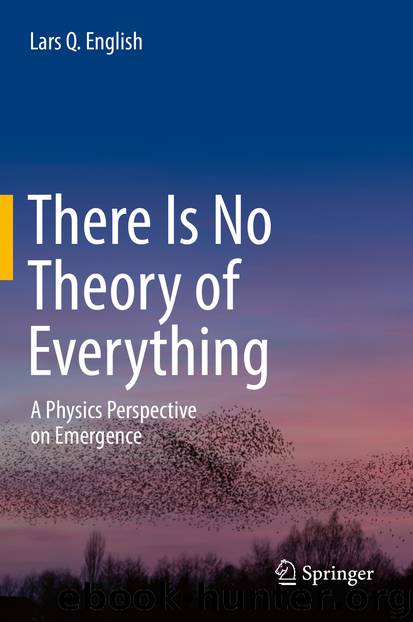There Is No Theory of Everything by Lars Q. English

Author:Lars Q. English
Language: eng
Format: epub
Publisher: Springer International Publishing, Cham
4.3 Phases, Protectorates, and Emergence
An adherent of strict reductionism might say, “In the final analysis, it is always microscopic law that determines macroscopic phenomena.” To which we can now reply: “Macroscopic phenomena are often entirely insensitive to the microscopic details? If a whole host of different microscopic systems and physical descriptions can yield the same macro-behavior, in what sense can we say that a particular microscopic law determined or caused the macroscopic behavior? In what sense could we say that the large-scale behavior is reducible to the microscopic law?”
Phase transitions in this way present a strong philosophical challenge for reductionists. It’s a challenge that isn’t easy to circumvent. And the renormalization group approach is perhaps one of the sharpest weapons wielded by proponents of emergence, for renormalization shields macroscopic phases from the reach of microscopic law. It carves out “protectorates” [5, 53]. These protectorates follow their own rules and have largely decoupled themselves from the details of their substrates.
To illustrate this point, think of a gas. The gas at high temperature is well described as simply a collection of individual atoms; a gas is made up of many, many replicas of the same quantum mechanical object—the atom. So from the gas phase, we can learn a lot about atomic physics, and in fact that’s pretty much all an atomic physicist can do. He or she studies gases and their interaction with light, their absorption lines, and so on—almost all we know about atoms comes from gases. But as we cool down the gas, eventually it has to go through a phase transition to become a liquid. And here is where the renormalization idea kicks in. During that process, a transformation takes place that involves self-similarity of scale and in the process de-couples the resulting state from the atomic physics that reigned supreme before in the gas. The physics of fluids is very different—fluid dynamics is not surprisingly a separate branch of physics. The liquid has carved out its own protectorate, its ontological independence from the gas. The self-similarity in turn relied on the correlation length going to infinity. One could argue that it was this singularity embedded in the phase transition that gave rise to the truly emergent nature of the liquid phase [54].
Some of these protectorates have properties that appear to go against their microscopic composition. A case in point is the solid-state phenomenon that goes by the endearing name of the fractional quantum-Hall effect. We’ll get to that in a bit, but first let’s back up a little. In fact, let’s back up about 135 years. The ordinary Hall effect is well known to any undergraduate physics student because of its usefulness in measuring magnetic fields easily and pretty accurately. It goes back to Edwin Hall who as part of his physics doctoral thesis at Johns Hopkins University discovered the effect that now bears his name. In 1879 he drove current through thin metal foils in the presence of a magnetic field, and a voltage developed between the opposite edges of the foil that were parallel to the flow of current.
Download
This site does not store any files on its server. We only index and link to content provided by other sites. Please contact the content providers to delete copyright contents if any and email us, we'll remove relevant links or contents immediately.
The Complete Stick Figure Physics Tutorials by Allen Sarah(6638)
Secrets of Antigravity Propulsion: Tesla, UFOs, and Classified Aerospace Technology by Ph.D. Paul A. Laviolette(3450)
Thing Explainer by Randall Munroe(3327)
The River of Consciousness by Oliver Sacks(2992)
The Order of Time by Carlo Rovelli(2714)
I Live in the Future & Here's How It Works by Nick Bilton(2524)
How To by Randall Munroe(2475)
A Brief History of Time by Stephen Hawking(2473)
The Great Unknown by Marcus du Sautoy(2186)
What If?: Serious Scientific Answers to Absurd Hypothetical Questions by Randall Munroe(2170)
Blockchain: Ultimate Step By Step Guide To Understanding Blockchain Technology, Bitcoin Creation, and the future of Money (Novice to Expert) by Keizer Söze(2137)
Midnight in Chernobyl by Adam Higginbotham(2078)
Networks: An Introduction by Newman Mark(1998)
The Meaning of it All by Richard Feynman(1909)
Easy Electronics by Charles Platt(1864)
The Tao of Physics by Fritjof Capra(1849)
When by Daniel H Pink(1777)
Midnight in Chernobyl: The Untold Story of the World's Greatest Nuclear Disaster by Adam Higginbotham(1775)
Introducing Relativity by Bruce Bassett(1754)
